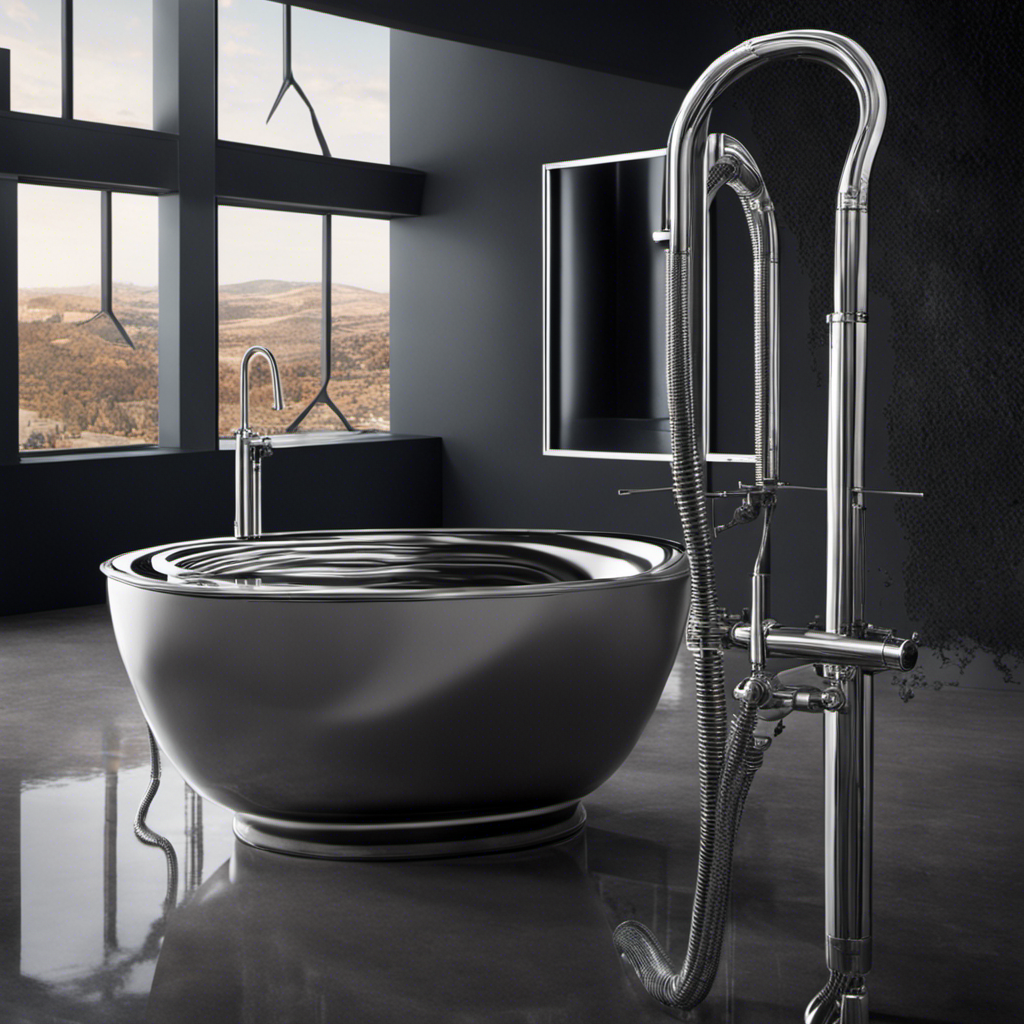As I stepped into my bathroom, a question crossed my mind: what lies beneath the seemingly tranquil surface of my bathtub? Curiosity piqued, I embarked on a journey to uncover the hidden secrets lurking underneath.
In this article, I will delve into the intricate world of structural support, drainage systems, water supply lines, insulation, and the flooring and subfloor that form the foundation of this essential fixture.
Prepare to be amazed as we unveil the mysteries of what truly lies beneath a bathtub.
Key Takeaways
- Structural support from floor joists and beams is crucial for the bathtub’s stability and prevents sagging or damage to the floor.
- Regular maintenance of the drainage system, including pipes, fittings, and traps, is necessary to prevent clogs and ensure efficient drainage.
- Water supply lines made of materials like copper, PEX, or PVC should be regularly checked for leaks and damage to ensure uninterrupted water flow.
- Choosing the right insulation type for the bathtub, such as fiberglass or foam board, is important for thermal protection, while proper flooring material like ceramic tile or vinyl and a clean, level, and dry subfloor are essential for installation.
Structural Support
The floor joists and beams provide the necessary structural support for the bathtub. It is essential for the structural integrity of the bathtub to have a strong and stable foundation.
The floor joists, typically made of wood or steel, are horizontal beams that span the distance between walls or supports. These joists distribute the weight of the bathtub and its occupants evenly across the floor, ensuring that the weight is properly supported. Additionally, the beams, which are vertical supports, provide further reinforcement and help to distribute the load downward. Proper weight distribution is crucial to prevent any sagging or damage to the floor and maintain the bathtub’s stability.
With the sturdy support of floor joists and beams, the bathtub can be confidently used without any concerns about its structural integrity.
With the structural support in place, the next important aspect to consider is the drainage system.
Drainage System
A common issue with bathtub drainage systems is clogs caused by hair and soap residue. The plumbing connections in the bathtub drainage system play a crucial role in ensuring proper water flow and preventing these clogs.
The plumbing connections consist of pipes, fittings, and traps that connect the bathtub drain to the main sewer line. These connections are typically made of PVC or ABS plastic, which are durable and resistant to corrosion.
Additionally, the overflow drain system is an important component of the bathtub drainage system. It prevents the bathtub from overflowing by providing an alternate path for excess water to drain. The overflow drain connects to the main drain and is equipped with a stopper to control water level.
Regular maintenance and cleaning of these plumbing connections and the overflow drain system can help prevent clogs and ensure the efficient operation of the bathtub drainage system.
Water Supply Lines
Make sure you regularly check the water supply lines for any leaks or damage. Proper maintenance of the plumbing connections is crucial to ensure a smooth and uninterrupted water flow in your bathtub.
During the installation process, the water supply lines are carefully connected to the bathtub fixtures, allowing water to be delivered to the tub. Here are two key aspects to consider when visualizing the water supply lines:
-
Pipes: These are the main conduits through which water flows. They are typically made of copper, PEX, or PVC and are installed beneath the bathtub. These pipes are connected to the main water supply and deliver water to the fixtures.
-
Valves: These control the water flow. You can imagine them as gatekeepers that regulate the water supply. Valves are strategically placed at various points along the water supply lines to allow for easy shut-off in case of emergencies or repairs.
Regularly inspecting your water supply lines will help identify any potential issues and prevent water damage. Once you’ve ensured the water supply lines are in good condition, it’s time to focus on insulating the bathtub.
Insulation
To properly insulate your bathtub, you’ll need to consider the type of insulation material that best suits your needs. There are several insulation types available for bathtub insulation, each with its own advantages and installation process.
Here is a table outlining some common insulation types and their characteristics:
| Insulation Type | Material | R-Value | Installation Process |
|---|---|---|---|
| Fiberglass | Glass | High | Cut and fit |
| Foam Board | Foam | High | Cut and glue |
| Spray Foam | Liquid | High | Spray and expand |
| Reflective | Foil | Low | Staple or tape |
| Cellulose | Paper | High | Blow-in |
When insulating your bathtub, it is important to choose an insulation type that provides adequate thermal protection and is easy to install. The installation process may vary depending on the insulation type, so be sure to follow the manufacturer’s instructions for the best results.
Flooring and Subfloor
When choosing flooring for your bathroom, it’s important to consider the type of material that best suits your needs and complements the overall design of the space.
There are various flooring materials available that are commonly used in bathrooms. Some popular options include:
-
Ceramic tile:
-
Offers durability and water resistance
-
Comes in a wide range of colors, patterns, and sizes, allowing for customization
-
Vinyl:
-
Provides affordability and easy maintenance
-
Resistant to moisture and stains, making it suitable for bathrooms
The installation process for bathroom flooring generally involves several steps. First, the subfloor needs to be prepared by ensuring it is clean, level, and dry.
Next, the flooring material is laid out, starting from one corner and working towards the opposite corner. Adhesive or mortar is used to secure the tiles or vinyl to the subfloor.
Conclusion
In conclusion, the bathtub is not just a simple fixture in our homes, but a symbol of comfort and relaxation.
Underneath its serene surface lies a complex network of structural support, drainage systems, and water supply lines. The insulation ensures the warmth and retains the heat of the water, while the flooring and subfloor provide a sturdy foundation.
Just like the layers beneath the bathtub, our lives are also composed of intricate and interconnected elements, each playing a vital role in creating a solid and fulfilling existence.










